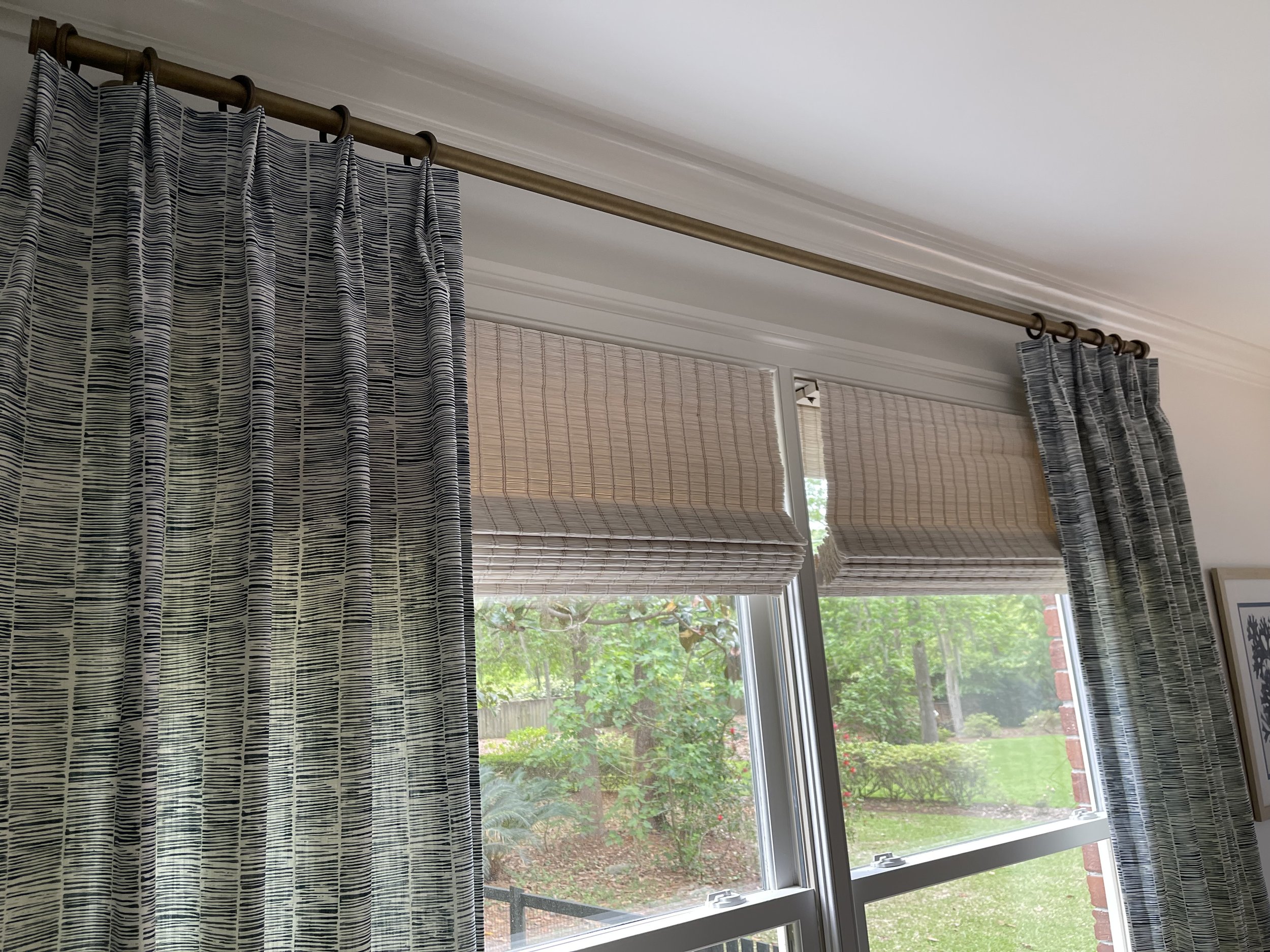Choosing the Right Drapery Hardware: Traverse Rods vs. Rod & Ring Systems
/When it comes to custom window treatments, hardware isn't just a practical necessity—it's a critical component that affects both function and style. At Savannah Window Fashions, we've seen firsthand how the right hardware choice elevates a project, while the wrong selection can lead to frustration and disappointment.
Our expertise comes from years of specifying hardware for projects throughout Savannah, Bluffton, and beyond—and our knowledge gained from our experience allows us to help our clients make informed decisions about their window treatment projects.
Understanding Your Drapery Hardware Options
When it comes to drapery hardware, there are two main systems to choose from: traverse rods and rod & ring systems. Each has distinct advantages and ideal applications.
Traverse Rod Systems
Traverse rods are track systems designed for smooth operation of draperies. They feature carriers that glide along a track, making them ideal for treatments that will be opened and closed frequently.
Key features of traverse rods:
Operation options: Can be motorized, baton draw, or cord draw
Drapery styles: Compatible with both ripple fold (wave fold) and pleated drapery styles
Functionality: Offers smooth movement, especially important for larger or heavier treatments
Look: Can be minimal with the track typically covered by a decorative fascia or valance
We recently designed and installed drapery and motorized traverse tracks for a Colleton River project with a 16’ expanse of windows and french doors. Our client wanted a user friendly operating system that would stand up to daily use. The pinch pleat draperies provide a classic look, and the motorized system means they can enjoy their outdoor areas at the push of a button.
Rod & Ring Systems
Rod and ring systems offer a more traditional and decorative approach to drapery hardware. These systems consist of a pole with rings that hold the drapery and slide manually along the rod.
Key features of rod & ring systems:
Visual elements: Decorative finials, poles, and rings become part of the overall design
Best applications: Ideal for shorter expanses, stationary panels or treatments that aren't frequently opened and closed
Considerations: Require proper support for heavier fabrics and longer spans
Customization: Available in many finishes, materials, and decorative options
Bypass Rings: Special rings that allow treatments to move past brackets
Key Considerations When Choosing Drapery Hardware
Functionality Requirements
The first question I always ask clients is how they plan to use their draperies. Will they be opened and closed daily? Are they primarily decorative? This simple question often determines which hardware system makes the most sense.
For large drapery panels that will be operated regularly, traverse systems can offer better functionality. While bypass rings and bypass brackets allow you to open and close draperies with more than one center support bracket, they are not always easy to operate.
Weight & Fabric Selection
Collaboration with Maureen Pacifici
The weight of your drapery fabric directly impacts hardware requirements. Heavier fabrics like velvet or those with interlining need stronger support systems. The same considerations are needed for oversize draperies. Motorization on a traverse track was the only practical solution for draperies on these windows in a downtown Savannah penthouse. These windows were more than 16’ tall, and would have been very difficult to operate with a cord draw system due to the size and weight of panels.
Span & Bracket Considerations
The length of your window or the area to be covered is another crucial factor. Longer spans require additional support to prevent sagging.
One common mistake we see is underestimating the number of support brackets needed. High-quality hardware systems can span greater distances between supports, but there are still limits.
Projection & Clearance
Proper projection (the distance the rod extends from the wall) ensures draperies have enough space to function correctly and hang well.
We often have drapery hardware installations that need to take into consideration multiple layers of trim details around the windows. Careful measurements and planning ensure the draperies clear all obstacles while maintaining the right look.
Specialized Hardware Solutions
French Returns
Collaboration with Sarah Bartholomew Design
French returns are rods that curve back to the wall without finials. This option provides a clean, tailored look that works well in both traditional and contemporary settings.
For this pool room in Bluffton, we installed French return rods that blended into the design rather than drawing attention to themselves, letting the draperies be the focal point.
Custom-Bent Rods
Architectural features like bay windows, curved walls, or dormer windows require specially fabricated hardware.
One recent interesting project involved a custom-bent rod for a dormer window. We used our careful measurements to design a template for a rod with a 4-inch projection and custom brackets to accommodate the architectural molding and fit within the limited wall space available. The rings are permanently welded in place to ensure proper spacing across the arch.
Hybrid Systems
Hybrid systems, like the Onaverse Traverse Track Hybrid, provide the look of a rod and ring and the functionality of a cord draw traverse rod.
Why Expert Guidance Matters
Bamboo drapery rods make for a lovely design, but they can be difficult to operate when opening and closing on a daily basis, with rings getting caught on the natural ridges inherent to bamboo. This makes for a frustrating user experience and leads to broken hardware components.
Drapery hardware might seem like a small detail, but it has a big impact on how your window treatments work and look. Errors in hardware selection can lead to:
Sagging rods
Difficult operation
Premature wear on drapery fabrics
Limited functionality
At Savannah Window Fashions, our ability to specify the right hardware comes from years of experience and product knowledge. We've seen what happens when hardware is incorrectly selected and know how to prevent these costly mistakes.
The Math Behind the Scenes
There's a surprising amount of math involved in properly specifying drapery hardware. Each component must be calculated precisely:
Rod length with exact deductions for brackets and finials
Correct number of rings based on drapery width and pleat spacing
Precise bracket placement and quantity
Accurate projection measurements
Center support calculations based on rod diameter and material
There's zero room for error in these calculations. Getting even one measurement wrong can result in hardware that doesn't fit or function properly.
Our Quality Control Process
Drapery hardware is a prime example of why our process includes opening and inspecting all orders upon arrival, rather than waiting until installation day.This allows us to address potential issues such as:
Incorrect quantities of brackets or rings
Finials that don't match what was ordered
Finish inconsistencies between components
Missing parts or hardware
Damaged items
By identifying these issues immediately, we can resolve them quickly with minimal impact on the project timeline. This level of quality control is part of the comprehensive project management that sets our full-service workroom apart.
The Value of Quality
While it can be tempting to save money on hardware since it's often partially hidden, quality hardware is an investment that pays off in durability, smooth operation, and overall satisfaction.
The difference between premium hardware and budget options becomes clear with daily use. Premium traverse systems glide smoothly, while quality rods and rings maintain their finish and function well for years.
Our Process: Getting Hardware Right
Collaboration with Arlen Brown
At Savannah Window Fashions, hardware specification is a key part of our approach to window treatments. We consider every detail, from the weight of the fabric to the architectural features of your space.
Our process includes:
In-person or virtual consultation to understand your functional needs and preferences
Precise measurements that account for all architectural elements
Detailed specification of appropriate hardware systems
Professional installation
Access to Diverse Hardware Options
Collaboration with Robyn Roberts Design
No two window treatment projects are alike, which is why we carry over 15 custom hardware lines. This extensive selection allows us to match the perfect hardware to each unique project, based on:
Budget considerations
Finish requirements
Rod length and weight capacity
Operation style preferences
Design compatibility
Specialized features needed
Having access to manufacturers like Helser Brothers, Ona Hardware, Finial Company, and many others means we can address virtually any hardware challenge. Whether you need traditional brass rings for a historic restoration or contemporary motorized systems for a new build, we have hardware options to suit the project.
Whether you're renovating a historic downtown Savannah home, building a new residence in Palmetto Bluff, or updating your space at The Landings, proper hardware selection ensures your custom window treatments will look good and function well for years to come.
Ready to explore hardware options for your window treatment project? Contact us to schedule a discovery call and learn more about our full-service approach to custom window treatments.



















